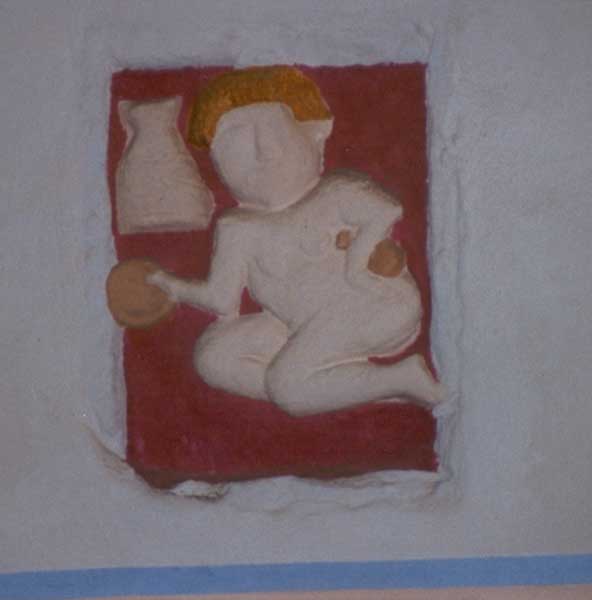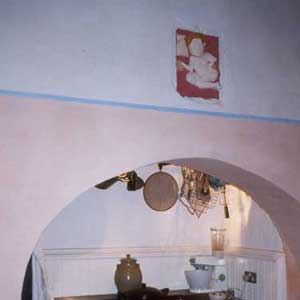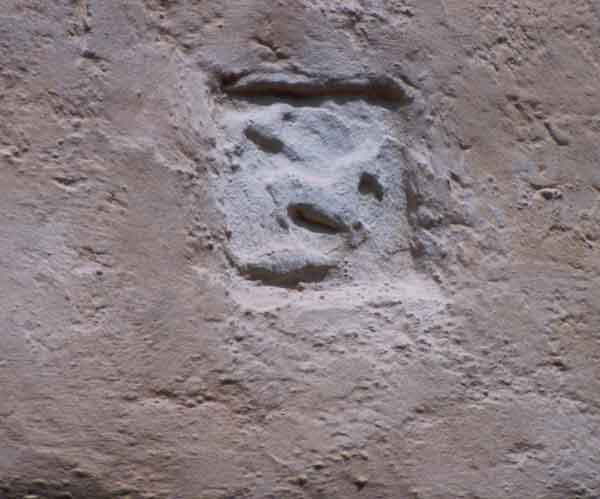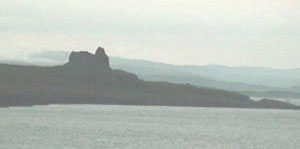The Butter Castle or "Caisteal an Ime"
This castle is on Morvern, on the west
edge of Scotland, just across from the Isle of Mull. The castle occupies
a commanding position atop a rocky summit at the head of Loch Aline, overlooking
a small peaty stream called Gear Abhain, or short river. The stream runs
by the castle into Loch Aline then finally into the Sound of Mull. The
area at one time had long been occupied by Clan MacInnes. Clan MacInnes
was keeper of the castle, which may have been used as a hold for supplies.
Clan MacInnes and MacMaster's remained as keepers of the castle after
the lands were granted to MacLean by charter.


Dubh-Chal
The kitchen
It was said that one of the Clan women,
Dubh-Chal (Lady of the Black Veil), paid the architect an amount of butter
equal in size to the castle, thus the name Caisteal an Ime or castle of
butter. The main fireplace has a carving of a woman holding an object
in one hand that some assume is Dubh-Chal. The new owners had the carving
painted in the same style as it may have been originally. Dubh-Chal is
buried at the Kiels (Kiel Church) along with (reported) several Chieftains
and the mother of St. Columba.


Salmon from Somerled fame?
The entrance, fish over the door
The castle is noteworthy in the size
of the boulders that were used to construct its walls. The castle is four
stories tall, measures 43 x 34 feet and has walls which are ten feet thick.
Most of the stones in the walls are composed of Lias limestone which contains
fossils, very rare in Scotland. Because of its size, it is not known for
sure if the castle was actually occupied or used as a hold. The ramparts
were made for pouring boiling oil with the unique feature of firepits
in the ramparts.
The outside holds a carving of what appears to be a fish, a salmon. Some have theorized that this is the salmon that Somerled wanted the MacInnes men to catch for him before he led them to oust the Norsemen that were terrorizing the settlement.
The outside holds a carving of what appears to be a fish, a salmon. Some have theorized that this is the salmon that Somerled wanted the MacInnes men to catch for him before he led them to oust the Norsemen that were terrorizing the settlement.
John Donald of Islay, Lord of the Isles, was the great-great-grandson
of Somerled. Chief MacInnes of Ardgour was a foster father, advisor
and councilor to John. MacInnes had advised John to divorce Amy
MacRuari in order to marry Margaret Stewart, the daughter of future
King Robert the Second of Scotland. In 1358, Amy got revenge by
telling John that MacInnes had complained that when he stayed at
John's house his quarters did not smell well because it was used
as a dog's kennel. John was enraged by this slur and ordered Donald,
son of Lachlan MacLean, to kill MacInnes. Donald did, and "having
killed his five sons, got himself possessed of Ardgour". We have two documents listed below that suggest the seizure of the land was not immediate but was in 1390 to a Lachlen MacLean of Duart. The
Clan never recovered, and many were scattered. The Clan has not
had a Chief since.
There is another version of the land siezure with MacMaster at a later date, about 1410-1420, where Donald MacLean (some have him as Ewen MacLean) asked the Lord of the Isles for some land, in which he replied Donald should "leap the dyke where it was the lowest". This implied the area around the MacMaster land where he was Laird of Ardgour. Donald and his grandfather, MacEarchorn, went to the residence. The MacLean's attacked MacMaster who was described as elderly and impoverished, and killed him. His eldest son escaped to Corran Ferry hoping to be taken across. But the ferryman, MacGurraclaich, refused saying "The 'cuddies' are taking too well to-night". The MacLeans caught up and killed the son. The ferryman bragged about not letting the son on, but Donald had him hung by his oars for not supporing the MacMasters and being disloyal.
So it is confusing which version had Donald MacLean seize the land. The loss of the Chief seems real in 1358 as this is when Amie was divorced, the MacMaster in 1410 was not considered a Chief. The documents below state the transfer was written in 1390 and given to Lachlan, Donald's father. The Castle was still occupied by MacInnes and MacMasters afterward as the castle was probably built in the 1400s. Please note that the MacInnes' of that area were also known as MacMaster, and MacInnes/MacMaster are used interchangably.
There is another version of the land siezure with MacMaster at a later date, about 1410-1420, where Donald MacLean (some have him as Ewen MacLean) asked the Lord of the Isles for some land, in which he replied Donald should "leap the dyke where it was the lowest". This implied the area around the MacMaster land where he was Laird of Ardgour. Donald and his grandfather, MacEarchorn, went to the residence. The MacLean's attacked MacMaster who was described as elderly and impoverished, and killed him. His eldest son escaped to Corran Ferry hoping to be taken across. But the ferryman, MacGurraclaich, refused saying "The 'cuddies' are taking too well to-night". The MacLeans caught up and killed the son. The ferryman bragged about not letting the son on, but Donald had him hung by his oars for not supporing the MacMasters and being disloyal.
So it is confusing which version had Donald MacLean seize the land. The loss of the Chief seems real in 1358 as this is when Amie was divorced, the MacMaster in 1410 was not considered a Chief. The documents below state the transfer was written in 1390 and given to Lachlan, Donald's father. The Castle was still occupied by MacInnes and MacMasters afterward as the castle was probably built in the 1400s. Please note that the MacInnes' of that area were also known as MacMaster, and MacInnes/MacMaster are used interchangably.
The murders were committed in Ardtornish
Castle, a few miles from Kinlochaline. The MacLeans were given the
land of Ardgour and the castle. Ardtornish is now in ruins. In 1997,
Sir Lachlan MacLean of Duart and Morvern offered an apology to Clan
MacInnes President William MacInnis.

Ardtornish Castle on the Sound of Mull
The castle was burned in 1644 when it was besieged by Coll Kitto of Colonsay during the wars of Montrose. The last attack on Kinlochaline was by the Earl of Argyll in 1679, during a feud. Kinlochaline was abandoned about 1690. Several restorations have occurred since that time, most noteworthy in 1890. The property is now privately owned and has undergone extensive renovation. See the Kinlochaline Proposed Alterations for more details. The new family has made Kinlochaline Castle home again after many years.
Notebien: The castle is
a private residence not open to tours or viewing. Please respect
the privacy of the residents.
References:
Williams, Ronald The Lord of the Isles. House of Lochar, 1997
10 Versions of the above tales
Clan MacInnes Society The Thistle and
the Bee August 2000
Some history on Kinlachine
Page 4 mentions Lachlan MacLean of Duart getting the lands.